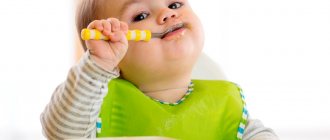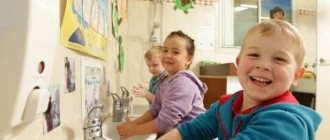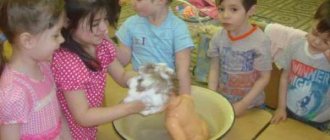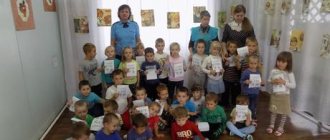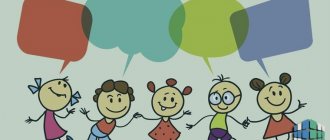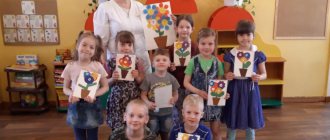September.
- “Let’s remember how to eat properly.”
Goal: To consolidate the skills of cultural behavior at the table, sit up straight, do not put your elbows on the table, drink and chew food quietly, use a knife, fork and napkin correctly.
D/I: “Table, cover yourself!”
- “Every thing has its place.”
Goal: To consolidate the ability to put away your things and toys, and maintain order in your locker.
D/I: “Find a place for the toy.”
- "Advice from Moidodyr."
Goal: To teach children to wash themselves properly, dry themselves using an individual towel, brush their teeth, rinse their mouths after eating, take care of their appearance, and keep their clothes clean.
D/I: “Hygiene rules.”
- “Who is the duty officer?”
Purpose: To consolidate children’s knowledge about the responsibilities of those on duty in the canteen, classes, and a corner of nature.
D/I: “Good or bad.”
October.
- "Polite words."
Purpose: To recall the forms of verbal expression of politeness when meeting and parting (hello, good afternoon, goodbye, all the best, etc.). Strengthen the skills of saying hello and goodbye, politely making requests, calling adults by their first name and patronymic.
D/I: “Good or bad.”
- “How we organize our closets.”
Goal: To form in children the habit of neatly folding clothes and putting them in the closet; keep your closet tidy.
D/I: “Good or bad.”
- "Advice from Moidodyr."
Goal: To develop the habit of quickly and correctly washing your face, drying yourself with a towel, and rinsing your mouth after eating.
Cultivate the habit of taking care of your appearance.
D/I: “Hygiene rules.”
- “How to make a bed.”
Goal: To teach children to make the bed: straighten the sheet, fold the blanket, tuck in the bedspread, smoothing out the folds. Form the habit of doing everything carefully.
D/I: “Let’s put the doll to sleep.”
November.
- “Let’s remember the rules of table manners.”
Goal: To consolidate the skills of cultural behavior at the table, sit up straight, do not put your elbows on the table, drink and chew food quietly, use a knife, fork and napkin correctly.
D/I: “Feeding the doll.”
- “Every thing has its place.”
Goal: To consolidate the ability to put away your things and toys, and maintain order in your locker.
D/N: “Pick up a pair.”
- “Why do you need to rinse your mouth after eating?”
Goal: to continue to formulate the concept of “healthy lifestyle”; explain why we need to rinse our mouths after eating.
D/I: “Hygiene rules.”
- “How to dry wet clothes.”
Goal: To consolidate the ability to dress and undress independently and quickly, put clothes in a closet, put shoes in place, dry wet things if necessary, care for shoes (wash, wipe, clean).
D/N: “Pick up a pair.”
December.
- "Let's remember the rules of politeness."
Purpose: To recall the forms of verbal expression of politeness when meeting and saying goodbye (hello, good afternoon, goodbye, all the best, etc.) To consolidate the skills of saying hello and saying goodbye, politely making a request, calling adults by name and patronymic.
D/I: “We teach the bear to make a request to the teacher.”
- “How well-mannered children behave.”
Goal: To teach children to greet guests, say hello, invite them to a group, offer to sit down.
D/I: “Let’s tell the bear how to greet guests.”
- Conversation "Good and bad"
Goal: To bring awareness to some rules of culture of behavior and moral qualities: it is good to be polite; They love polite, kind and attentive people; they are good to play with and be friends with.
D/I: “Good or bad.”
- “We have guests coming.”
Goal: Remember the rules of table setting, rules of behavior at the table.
D/I: “Table, set it up.”
January.
- "Culture of behavior during eating."
Purpose: To teach children to set the table, to name the items needed for reference. Introduce the rules of etiquette (meeting guests, accepting gifts, inviting people to the table, behavior at the table).
D/N: “Get started on lunch.”
- “How we organize our clothes closet.”
Goal: To consolidate the ability to independently maintain cleanliness and order in your closet; cultivate a caring attitude towards things.
D/I: “The crocodile is neat.”
- "How to take care of your clothes."
Goal: To cultivate a caring attitude towards your clothes; Form the habit of neatly folding clothes.
D/I: “Good or bad.”
- "Patience and a little effort".
Goal: To develop a desire to work, to be able to offer one’s help to someone.
D/I: “Let’s help Mishka.”
February.
- "Politeness in conversation."
Goal: To consolidate the skills of saying hello and goodbye, politely making requests, calling adults by their patronymic name. Strengthen the ability to thank for food and help. Learn to help each other and turn to friends for help.
D/I: “Good or bad.”
- Conversation “How well-mannered children play.”
Goal: To cultivate a friendly attitude towards each other, a desire to play together, to have pity, to help; continue to teach not to take away toys from each other.
D/I: “They brought a new toy to the group, everyone wants to play with it.”
- “We have guests coming.”
Purpose: To familiarize children with the names of tea set items, to discuss the rules for setting the table for tea.
D/I: “Let’s give the doll some tea.”
- “Who is a good person?”
Goal: To form ideas about kindness, honesty, justice, friendship, to cultivate a negative attitude towards immoral qualities: cunning, greed, cowardice, deceit, laziness, betrayal, vanity, etc.
Strengthen the ability to fairly evaluate your own actions and the actions of your peers.
D/I: “Good or bad.”
March.
- “Food culture is a serious matter.”
Goal: To introduce children to the culture of cooking.
D/I: “Who can name the most dishes?”
- “Cleanliness is the key to health.”
Goal: To foster a desire to lead a healthy lifestyle; form the habit of being clean and tidy.
D/I: “Hygiene rules.”
- "We are friendly guys."
Goal: Continue to strengthen children's social behavior skills: thanking for the help and care provided, politely saying goodbye, providing support to comrades in difficult times. Continue to form cooperative relationships in children when solving educational problems, and cultivate in them the ability to empathize with the successes and failures of their comrades.
D/I: “Good or bad.”
- "The way we talk to each other."
Goal: To teach children to communicate calmly, without shouting.
D/I: “It’s possible, it’s not possible.”
April.
- “We have guests coming.”
Goal: To teach how to greet guests, to cultivate a friendly attitude towards guests.
D/I: “Etiquette is a school of graceful manners.”
- "Cutlery".
Goal: To consolidate the skills of cultural behavior at the table: sit up straight, do not put your elbows on the table, drink and chew food quietly, use a knife, fork and napkin correctly.
D/I: “Let’s feed the animals salad.”
- “Every thing has its place.”
Goal: To develop the habit of quickly dressing and undressing, hanging clothes in a certain order and place.
D/I: “Good or bad.”
- "We are polite children."
Goal: To consolidate behavior skills in public places.
D/I: “It’s possible, it’s not possible.”
May.
- “We know how to behave properly at the table.”
Goal: To consolidate the skills of cultural behavior at the table: sit up straight, do not put your elbows on the table, drink and chew food quietly, use a knife, fork and napkin correctly.
D/I: “Etiquette is a school of graceful manners.”
- "We are polite."
Goal: Continue to reinforce social behavior skills in children: greet adults first, speak quietly, say goodbye politely, and do not disturb others.
D/I: “It’s possible, it’s not possible.”
- "We are careful."
Goal: Continue to develop the habit of quickly and correctly washing your face, drying yourself with a towel, rinsing your mouth after eating, and taking care of your appearance; dress and undress quickly, hang clothes in a certain order and place, keep clothes and shoes clean.
D/I: “The crocodile is neat.”
- "We are friends".
Goal: Continue to form ideas about kindness, honesty, justice, friendship.
Continue to teach children to take into account the opinions and interests of others, to protect the weak, and to help their comrades.
D/I: “Good or bad.”
Didactic games to develop cultural and hygienic skills
and culture of behavior:
- “Table, cover yourself!”
Goal: To strengthen the skills of setting a children's table.
Progress of the game: participants draw out leaves with images of dishes for different stages of nutrition (breakfast, lunch, afternoon snack, dinner) and set the tables using flat figures.
- “Find a place for the toy.”
Teach children how to properly place play materials and treat them with care.
Game tasks. 1. Play with toys (2-3 new toys) - recite a poem, ask a riddle, find out by description, etc. 2. Put toys in place. Evaluate together the correctness of the task: where is the best place for toys. The role of the leader can be played by the teacher or the child.
Equipment. Toys.
- "Rules of hygiene."
Using a counting rhyme, the driver is selected and leaves the group. The teacher and the children agree on who will portray what and what. Then the driver is invited, the children take turns demonstrating hygiene skills using gestures and facial expressions. The presenter must guess what the children are showing: washing, brushing teeth, wiping, combing their hair, bathing.
Cultural and hygienic skills in the preparatory group of kindergarten, card index with goals
Education of cultural and hygienic skills (CHS) is an important component of the formation of the personality of a preschooler. Therefore, this area of educational work runs like a red line through the entire educational process in kindergarten.
In the preparatory group (children 6–7 years old), developments in this area are expanded, systematized and generalized, thereby providing the basis for further expansion of the skill at the next stage of education, that is, during schooling.
Since the upbringing of KGN is a continuous process, it is very important to correctly dose the development of each skill, for example, quarterly (in quarters). And the distribution of skills across four areas of self-care helps to streamline this activity:
- table manners skills;
- dressing and undressing;
- water procedures;
- keeping personal belongings and sleeping space in order.
. CGN training should proceed in parallel in kindergarten and at home.
In the preparatory group, children learn basic table manners
Methodological techniques for educating KGN in the preparatory group
When working with children 6–7 years old, the importance of speech techniques increases, since at this age, in the combination of visual and figurative perception, the advantage goes to the latter.
And since the children have already completely mastered speech, the creation of images is based precisely on this source of information.
At the same time, other methods of interaction - visualization, games, practice - are used no less actively.
In the work on educating KGN, it is important to rationally use the entire arsenal of methodological techniques
As already noted, the work of educating KGN with preparatory students is inextricably linked with the formation of positive moral qualities, which, in turn, determines the importance of such a technique as an ethical conversation, in particular, discussion of issues related to the culture of addressing acquaintances and strangers, education habits of keeping track of your things, etc. You can see an example of the topics of conversations on KGN in the preparatory group in the publication of teacher Lomovskaya L.V.
Explanation
In the context of KG education, clarification is used to determine the order of actions when practicing a specific skill.
For example, the process of sewing on a button can be described as follows: “We pull the thread into the needle, tighten the ends into a knot, and insert it into the needle bed. We apply the button to the item in the place where it came off.
Take a needle and thread and pull the buttons through the hole from the inside out to the face. We make a stitch by passing the needle into the adjacent hole and return it inside out. We repeat the stitches.”
. The explanation of practical activities related to CGN is often in the nature of a motivational device that encourages mastering a particular skill: sewing on a button, washing a handkerchief, etc.
Many preschool teachers call this technique a win-win motivation: on the one hand, rhymes attract the attention of kids - everyone wants to distinguish themselves and guess, and on the other hand, they set them up for further development of the topic. These techniques usually begin the consideration of the topic on KGN.
For example, in my practice, when considering the topic “Water, Soap, Towel,” dedicated to developing the ability to soap your hands and face, thoroughly rinse off the foam with water and dry yourself, I begin with riddles:
- It can be family, household, bath, It can be fragrant or it doesn’t smell at all, It can be different colors, sizes and shapes of any kind, But it can only be slippery with water! (Soap);
- Without it we are nowhere: “neither here nor there.” We all need very clean... (water) for life;
- Long path, Two embroidered ends, Soft and clean After washing, it will dry me out. (Towel).
The answers to riddles can be specific practical actions of children
These two techniques can be used successfully either separately or in combination. And in both cases, mainly for motivation.
In the first case, an adult or trained children recite poems before practical mastery of the skill. In my work I use this option in the form of excerpts from “Moidodyr” by K.
Chukovsky, which children tell before repeating the order of putting things in a locker and the importance of clean bed linen.
Reading is practiced in two forms: either the children themselves read texts relevant to the topic, or an adult does it.
Of course, the first option is more effective, since it allows children to better understand the essence of the work and also develops an important skill that determines the level of readiness of children for school.
But since it is still difficult for children 6–7 years old to read entire poems or prose works, the texts should be divided into meaningful passages. For example, O. Grigoriev’s poem “Jam” can be read in two lines:
- Sergei has no patience, he eats jam with his hands. Seryozha’s fingers stuck together, his shirt grew to his skin. You can’t take your feet off the floor, You can’t take your hands off your feet. Elbows and knees stuck together, Ears stuck together with jam. A pathetic sob is heard - Sergei stuck to himself.
After which, in a conversation, the kids discuss the main idea of the rhyme: in order not to find yourself in Sergei’s situation, you must not forget about the culture of eating.
Reading also helps to attract children's attention to the topic at hand.
Visibility
To educate KGN from this group of techniques, the teacher uses:
- pictures (and not only to accompany the explanation, illustration of each stage of practicing a skill, but also as a demonstration of the stages “before” and “after”, for example, the hero of “Dunno in the Sunny City” N. Nosov Pachkuli Pestrenky before washing and after as a way to awaken the kids’ curiosity about what helped him transform like that);
- attributes (kids need to be introduced to different forms of personal hygiene products - solid and liquid soap, a regular and electric toothbrush, washcloths of different shapes, etc., so that in the future they will not have misunderstandings regarding the use of soap in the form of candy or a toothbrush with a cap in in the form of a toy);
- demonstration (any skill - using a fork, a napkin, tidying up a cabinet, changing bed linen, etc. - requires a presentation by a teacher);
- demonstration (if in younger groups this technique in the form of cartoons directly explained the essence of a particular skill, then in older preschool age video materials can be used as motivation for a subsequent conversation on the topic).
The game form of work does not lose its relevance in the preparatory group. In the aspect of education, KGN are used:
- outdoor games (usually in the form of competitions “Who can make the bed better”, “Who can perform hygiene procedures faster after returning from a walk”, etc.);
- theatrical games (this technique is indispensable when developing a culture of behavior at the table, when children in role-playing games appear as visitors to a cafe, guests of the king); Work on educating KGN combines routine moments with practicing skills
- didactic games that allow you to reinforce the order of performing a particular hygiene procedure.
. Games can be used as an element of motivation before direct productive activities.
The game Let's dress the doll Masha for a walk can be carried out in the reverse order, that is, undress after the walk. In the game Develop good habits, children, among other things, develop monologue speech. For each correct answer in the game Rules of Hygiene, the child receives a point
This is the actual implementation by children of CGN in life, as well as:
- experimental activity (for example, to prove that there are stains that cannot be wiped off, but only washed off, children draw a small spot on their hand with a ballpoint pen, then try to erase it, but only stretch the blot, and go to the washbasins, where they wash off the ink with soap and water );
- creative tasks (drawings, crafts, applications) on the topic.
Photo gallery: drawings by children of the preparatory group on the topic of educating KGN
Drawing images can be created together with parents. In the drawings, children can depict the order of performing a specific group exercise. Drawings on the topic of healthy lifestyle can be general in nature.
Card index of topics on KGN for children 6–7 years old
When compiling a card file of topics for the education of children of children, the teacher is guided by the skill being practiced in a specific period of time, and also takes into account that work on improving self-service skills in children 6–7 years old is closely related to the formation of positive moral qualities. In particular, practicing the ability to politely point out to a friend the shortcomings in his appearance or culture of behavior. You can see an example of such a file cabinet here.
As for the structure of the file cabinet, based on my experience, I can say: it is convenient to organize it according to the model of a long-term plan - quarterly. At the same time, the teacher chooses suitable techniques for work according to the topic of a particular school day.
. The choice of technique can be carried out by precedent: for example, if the teacher noted that some children do not use soap to wash their hands, then it would be appropriate to conduct a didactic game “Let’s tell the kids about how to wash their hands.”
Its essence is that children receive a cardboard doll and a set of cards depicting hygiene items (soap, towel, toothbrush, washcloth, etc.).
The children’s task is to select everything that is needed for washing their hands, and then comment on the purpose and order of use of the attributes.
In games to educate CGN, children enrich their personal experience by improving their skills
Table: card index of topics on education of CGN in children 6–7 years old
Author - Vasylishin N.A., teacher of kindergarten, school-gymnasium No. 60, Lugansk.
Education of KGN occurs systematically throughout the academic year
Goals and objectives of classes on KGN in the preparatory group
As in any other type of direct educational activity (DED), when developing a lesson on CGN, it is important for the teacher to correctly formulate goals and objectives, taking into account that they necessarily include the following areas:
- educational (what new things the children will learn, for example, a work of art, historical information, etc.);
- developmental (what specific skill is being practiced - table manners, personal hygiene, etc.);
- educational (how this or that skill affects the improvement of the general culture of the individual).
: about the rules of visual hygiene for children in the preparatory group
In the preparatory group of a kindergarten, the education of KGN is in the nature of generalizing the knowledge and skills acquired earlier.
Children practice hygiene skills, learn to take care of their things, keep them in order, and also learn table manners, including the traditions of using cutlery.
All these components of education of a culture of health should be included by the teacher in drawing up the plan and notes for classes on CPG.
Source: https://melkie.net/zanyatiya-s-detmi/kgn-v-podgotovitelnoy-gruppe-kartoteka.html
Card index of topics on KGN for children 6–7 years old
When compiling a card file of topics for the education of children of children, the teacher is guided by the skill being practiced in a specific period of time, and also takes into account that work on improving self-service skills in children 6–7 years old is closely related to the formation of positive moral qualities. In particular, practicing the ability to politely point out to a friend the shortcomings in his appearance or culture of behavior. You can see an example of such a file cabinet here.
As for the structure of the file cabinet, based on my experience, I can say: it is convenient to organize it according to the model of a long-term plan - quarterly. At the same time, the teacher chooses suitable techniques for work according to the topic of a particular school day.
This is interesting. The choice of technique can be carried out by precedent: for example, if the teacher noted that some children do not use soap to wash their hands, then it would be appropriate to conduct a didactic game “Let’s tell the kids about how to wash their hands.” Its essence is that children receive a cardboard doll and a set of cards depicting hygiene items (soap, towel, toothbrush, washcloth, etc.). The children’s task is to select everything that is needed for washing their hands, and then comment on the purpose and order of use of the attributes.
In games to educate CGN, children enrich their personal experience by improving their skills
Table: card index of topics on education of CGN in children 6–7 years old
Author - Vasylishin N.A., teacher of kindergarten, school-gymnasium No. 60, Lugansk.
| Period | Themes | Methodical techniques |
| First quarter | "How to eat deliciously" |
|
| "I myself" |
| |
| "Water, soap, towel" |
| |
| "Putting the crib to bed" |
| |
| Second quarter | "At the King's Reception" |
|
| “Every thing has its place” |
| |
| "Purity" |
| |
| “We don’t want to be dirty” |
| |
| Third quarter | "Table manners" |
|
| "Why is it important to dress yourself" |
| |
| "We love to swim" |
| |
| "Why is hygiene necessary" |
| |
| Fourth quarter | “Culture of behavior at the table in public places and at home” |
|
| "Letter from the Incompetent" |
| |
| “We care!” |
| |
| "Fighting Torn Buttons" |
|
Education of KGN occurs systematically throughout the academic year
Goals and objectives of classes on KGN in the preparatory group
As in any other type of direct educational activity (DED), when developing a lesson on CGN, it is important for the teacher to correctly formulate goals and objectives, taking into account that they necessarily include the following areas:
- educational (what new things the children will learn, for example, a work of art, historical information, etc.),
- developmental (what specific skill is being practiced - table manners, personal hygiene, etc.),
- educational (how this or that skill affects the improvement of the general culture of the individual).
Table: examples of wording of goals and objectives of classes on educating KGN in the preparatory group
| Subject | Goals | Tasks |
| "We're looking for a blot" |
|
|
| "All about personal hygiene" | Formation of ideas about a healthy lifestyle in children. |
|
| "Dining etiquette" | Expand your knowledge of table etiquette. |
|
Table: Smirnova I.A. lesson notes on the topic “Everything about personal hygiene” on the education of KGN in the preparatory group (fragments)
| Stage | Content |
| Introductory | Dear Guys! Today we received a letter. Let's read it. (The teacher reads “A Letter to All Children on One Important Matter” by Y. Tuvim). |
| Basic | Educator: - Everyone should take care of their body, both adults and children. What can happen if you don’t wash, don’t wash your hands, don’t wash your face? Children's answers. Do you know what happened to one boy who didn’t wash his face? The teacher reads an excerpt from K. Chukovsky’s fairy tale “Moidodyr”. — You were absolutely right in saying that you can get sick if you don’t wash your hands or wash your face. Our body is covered with skin, and it protects our internal organs from germs...>, <,... We need to take care according to certain rules. And these rules are called “Rules of Personal Hygiene”. (children repeat)…>, |
| <,... - What items do you think we will need to maintain personal hygiene? Try to guess the riddles...>, | |
| <,... Riddle: A cunning hedgehog has settled on a shelf near the mirror. With him you will comb the Katya doll and braid her hair. Hairstyle will become fashionable, If you work... (comb). Q: - Do you know why you need to comb your hair? Maybe this is not necessary at all? (answers)…>, | |
| <,... Q: - And now, to check how you remember what we talked about, I suggest playing the game “What can I share.” I have a "Wonderful Bag". It contains hygiene items. And on the table there are 2 boxes: red and green. In the red box we will put items that we cannot give to others, because these are personal items, and in the green box we will put those items that everyone can use...>, | |
| Fixing the material | <,... - Guys, what did we talk about today, what interesting things did you learn? (children's answers). |
| The final stage | - So we repeated the rules of personal hygiene. You understand how important it is to take care of yourself, keep your body clean, be neat, tidy, clean, and therefore be healthy. Because cleanliness is the key to health! — And in conclusion, let’s listen to the song “If children wash themselves in the morning...” |
Education of cultural and hygienic skills
Definition 1
Cultural and hygienic skills are an important component of a culture of behavior, which represents the skills of maintaining neatness, keeping one’s face, hands, body, clothes and shoes clean.
The formation of cultural and hygienic skills is not only the assimilation of norms and rules of cultural behavior, but also a very important process for a child’s entry into society and his socialization.
Every child from early childhood must understand and follow the rules, realize that being untidy, dirty and sloppy is ugly and uncultured.
A person’s appearance forms the first idea of him as a person.
The process of hygienic education and training is closely related to the education of cultural behavior. From early childhood, the child is taught to sit correctly at the table, eat carefully, use cutlery, learn to speak politely and kindly with others, maintain neatness in appearance, introduce the rules of behavior in society, etc.
Can not understand anything?
Try asking your teachers for help
Note 1
The child must not only know all cultural and hygienic rules, but their observance must be brought to automaticity.
Objectives of developing cultural and hygienic skills
Education of cultural and hygienic skills involves solving the following range of problems:
- Development of cultural and hygienic skills in children, formation of simple behavioral skills during daily toileting, eating, etc.
- Forming a strong habit of taking care of one’s own appearance, the ability to use toiletries (soap, toothbrush, towel, comb, etc.).
- Formation of table manners and ability to use cutlery.
- Formation of basic ideas about the importance of one’s own health and the ability to maintain and strengthen it; establishing a clear rule that “cleanliness of the body is the main guarantee of health.”
- Formation of a persistent need to observe the rules of hygiene and neatness in everyday life.
- Involving parents of pupils in the formation and development of cultural and hygienic skills in children in a family environment.
- Enrichment of the subject-developmental environment of preschool educational institutions.
The successful solution of these problems is carried out through the use of a number of pedagogical techniques that the teacher uses in working with students, taking into account their age:
- Direct training
- Show
- Exercises that involve performing specific actions during educational games
- Systematic reminders to children about hygiene rules and their observance (in routine moments, games, etc.)
- Gradual increase in requirements for compliance with hygiene rules and the formation of self-control skills for their implementation
These techniques can be used individually or in combination. The integrated use of techniques is advisable for children of older preschool age.
